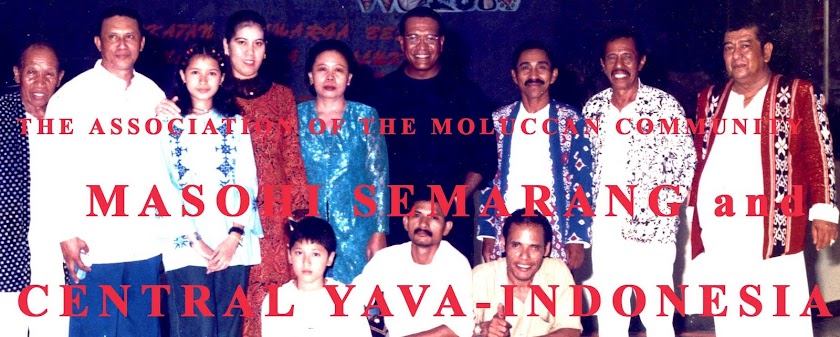Male and Female Philosophy
According to the view of the Ternate person the time previously, early of the beginning of the life was begun from two human nooses, that is the man and the woman, who were assembled in a household and produced the previous family next to the extended family that was mentioned “Marga” and continued to “Suku” and again bigger was concrete one ”Nation”. From the two men and this woman the birth of a community, then in the view of the Ternate person, the male noose and the very main woman was the beginning of a life so as the man and this woman became the main omen in the view of the traditional community in Ternate.
According to the local legend, early of the beginning of the formation of unity of the community in Ternate by two clan groups, that is; “Tobona” and “Tabanga”. Tobona was the accumulation from the existence of two clans that is Tubo and Tabanga personally, whereas Tabanga was the accumulation from the existence of the Toboleu clan and Tabanga personally. The Tobona clan was mentioned by the name of “Cim” (the woman), whereas the Tabanga clan was mentioned by the name of “Heku” (the man). The two clans afterwards developed became bigger and immediately give birth and had children pinak afterwards was formed by unity of the community that was wide with the ruler had the shape of the kingdom or in the local language was mentioned “Buldan”. Then as the sign for that, the symbol of the Ternate Royal took the form of eagle birds that two head, that was known with “Goheba Ma dopolo romdidi”.
Goheba ma Dopolo Romdidi
Birds of the land eagle, that in the Ternate language were mentioned “Wuru” was the symbol for the group Cim (the woman) whereas birds of the sea eagle, that in the Ternate language were mentioned “Goheba often also was pronounced by Kuheba” was the symbol for the Heku group (the man). Heku and Cim with the symbol of eagle birds that two head that was worn as “Symbolic of Ternate Royal”. The symbol that contained this philosophical meaning was poured in various life means of the tradition, that used the meaning of the man and the woman. For example real that still there till at this time, are those that was presented in life means of the tradition by using the meaning of the man and the woman was;
1. In building a house, will be gotten two long beams the part on the house that was acknowledged as “Dalul se Hate Gila” that is male wood and female wood.
Dalul se Hati Gila
2. To each boat that used the screen, will be gotten two ropes the screen that was acknowledged as “Gumi Nonau se Buheka” that is the male rope and the female rope. Gumi Nonau was the rope the upper part screen was with his position tied and continue to to his place whereas Gumi Buheka was the rope penahan the screen for low that was not tied and only was held to maintain the balance of the screen when being blown the wind.
3. In the performance of traditional food:
a. Jaha or Pali-pali, was a kind of rice that was cooked inside a part of bamboo or was wrapped in the sago palm leaves (the leaves of the sago tree) that was formed memanjang approximately 40 cm with the diameter 3 cm totalling ten pieces that were located and were assembled on a plate/the forum resembled the boat, the omen of sea (Heku/the man)
Jaha se Pali-Pali
b. The chest (the Steamer) was tumpeng rice that was despised on a plate and was formed resembled a mountain, the omen of the mainland (Cim/the woman).
c. The fish (the omen of the woman) and the eggplant (the omen of the man) that was given sauce was located in a white plate. The performance of Betel and Penang in the wedding ceremonial, omen betel of the man and omen betel nuts of the woman. During wedding ceremonial, when the second agreement happening the side then the performance of betel and betel nuts were accepted by means of digested with the white lime so as the main point of cud became red. This colour contained the meaning that the man and the woman joined in a household that was preceeded with the sign one “hymen” in the night.
d. In the expression from one of the forms of oral Ternate literature, namely “Bubaso se Rasai”. Bubaso meant the feeling expression of the man whereas Taste was the feeling expression of the woman.
Traditionally Phylosophy of Ternatenese (The Six Philosophy)
The life order with the binding oral rule the person’s Ternate community in the context of “Traditional community” originated in the six philosophy of Ternate people that was current. This traditional philosophy was the ancestors’s inheritance. The six philosophy of Ternate people was the implementation from the original cultural root the Ternate person personally, that is; “Adat Ma Toto Agama, Agama Ma Toto Toma Jou Rasulullah, Jou Rasulullah Manyeku Iye Diki Amoi Nga Kuasa se Kodrati”. (the Tradition originated in the religion, the religion originated in the Muhammad teaching, he was upper Muhammad only guidances and upper is the Lord”. The six philosophy of Ternate people was to be the inheritance from the ancestors that in the Ternate regional language were acknowledged as “Kie se Gam Magogugu Matiti Rara”, consist of:
1. ADT SE ATORANG, The basic law that must be obeyed and compiled conventional that could be received by all the social strata. Meaning that the tradition that was based on the rule.
2. ISTIADAT SE KABASARANG, customs The traditional agency with his authority according to the provisions of the current tradition was revered as guarded martabat the Ternate person.
3. GALIB SE LIKUDI, The long refractivity that became the ethnic group’s grip was arranged according to the foundation of the provisions that dilazimkan in the community and was adapted with the time without having the conflict.
4. NGALE SE the CARA/DUKU, The form of their respective culture the ethnic group could be used together in accordance with the wish for cohesiveness in the difference.
5. SERE SE DUNIRU, lemon grass The life order of art and the culture and the habit that emerged in the association of the community were accepted together.
6. CING SE CINGARE, The provisions of the regulation about the woman and his man. Meaning that each individual and the man’s couple and the woman was unity that was intact with the right and the obligation each must be built and guarded by his conservation because of the Ternate person always mean male philosophy and the woman Like that it was explained above.



























0 komentar:
Post a Comment